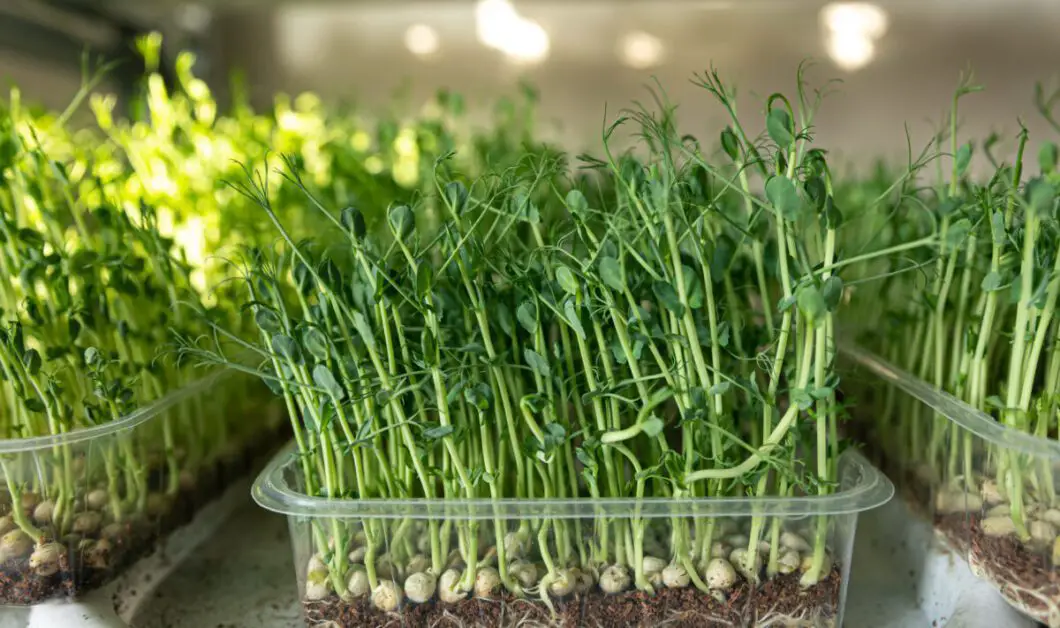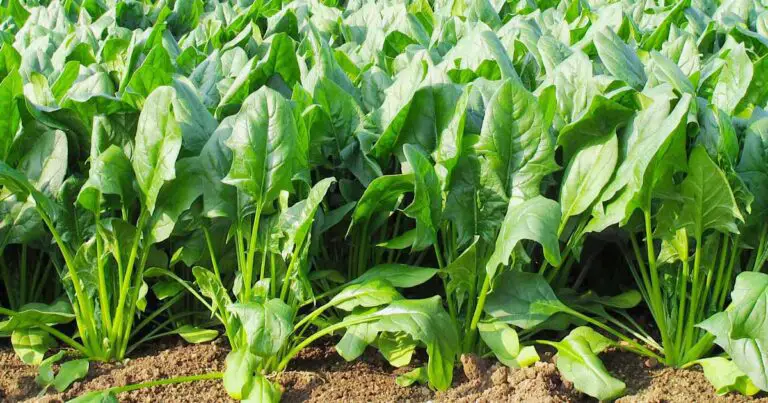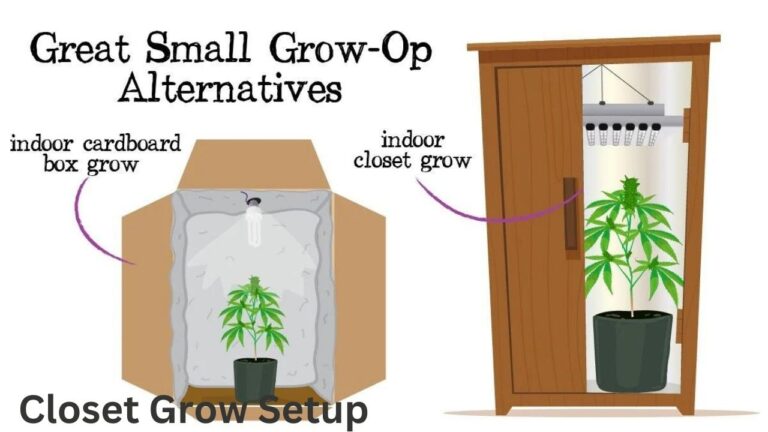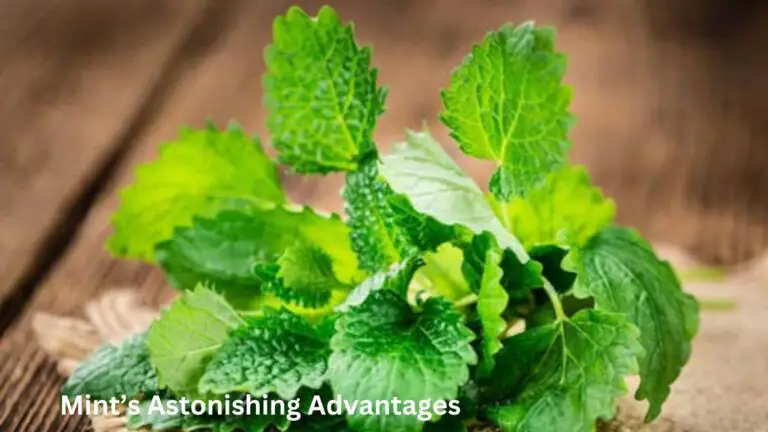Pea Shoot Microgreens: How to Grow Them in 5 Simple Steps
Table of Contents
Understanding the Basics of Pea Shoot Microgreens
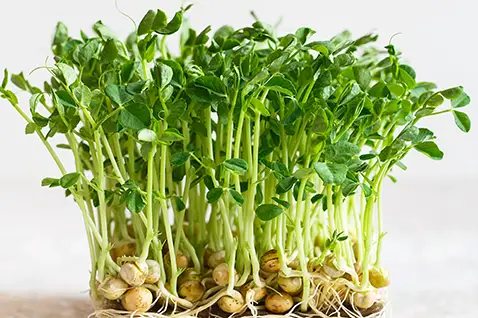
Pea shoot microgreens are a popular choice among gardening enthusiasts due to their vibrant color, delicate flavor, and numerous health benefits. These tiny greens are harvested when the plants are still young and only a few inches tall, making them a perfect addition to salads, sandwiches, and various other dishes. But what exactly are pea shoot microgreens, and how do they differ from regular pea plants?
Simply put, pea shoot microgreens are the young seedlings of pea plants that are harvested at an early stage of growth. During this stage, the shoots are packed with essential nutrients, including vitamins C and A, as well as iron and fiber. The intense flavor of pea shoot microgreens is reminiscent of fresh peas, lending a sweet and slightly grassy taste to any dish. Additionally, these microgreens are known for their crunchy texture, providing a delightful contrast to softer ingredients. Now that we have a basic understanding of what pea shoot microgreens are, let’s delve into the process of growing them and uncover the secrets to cultivating healthy and vibrant plants.
Selecting the Right Pea Variety for Microgreens
Pea shoot microgreens are not only delicious but also packed with nutrients, making them a popular choice for home gardeners and culinary enthusiasts alike. When it comes to selecting the right pea variety for microgreens, there are a few key factors to consider.
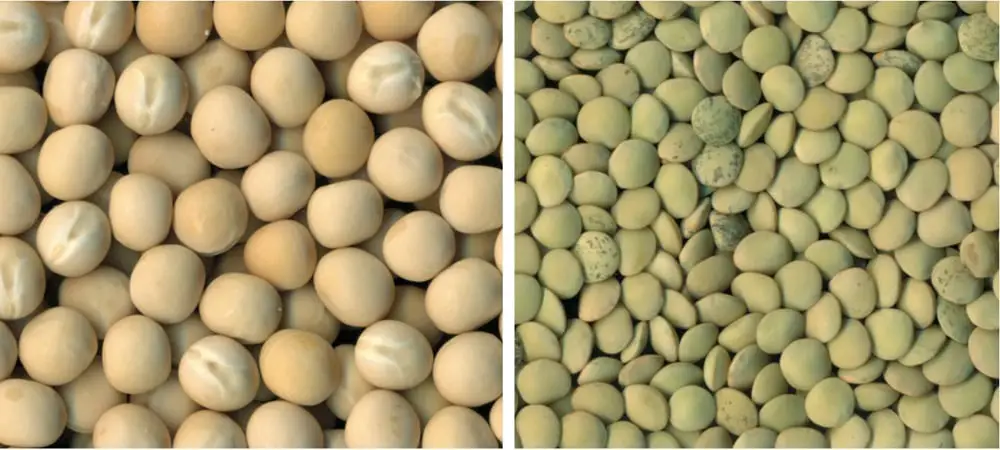
First and foremost, it is important to choose a variety that is specifically bred for microgreen production. These varieties are typically fast-growing and have tender, flavorful shoots. Look for varieties such as “Dwarf Gray Sugar,” “Oregon Giant,” or “Little Marvel,” which are known for their excellent taste and texture when harvested as microgreens. These varieties have been selected for their compact growth habit and high yields, making them ideal for small-scale cultivation.
In addition to taste and texture, consider the color and visual appeal of the pea shoots. Some varieties, such as “Golden Sweet” or “Carouby de Maussane,” produce vibrant golden or purple shoots that can add a splash of color to your dishes. This can be particularly appealing for culinary enthusiasts who enjoy creating visually stunning meals. Ultimately, the choice of pea variety for microgreens will depend on your personal preferences and the intended culinary use.
Remember, selecting the right pea variety is just the first step in successful microgreen cultivation. It is also important to source quality seeds and take proper care of the plants throughout their growth cycle. This involves providing optimal growing conditions, such as adequate light, temperature, and moisture levels. By selecting the right pea variety and providing optimal growing conditions, you can ensure a bountiful harvest of delicious and nutritious pea shoot microgreens.
Sourcing Quality Pea Seeds for Microgreen Cultivation
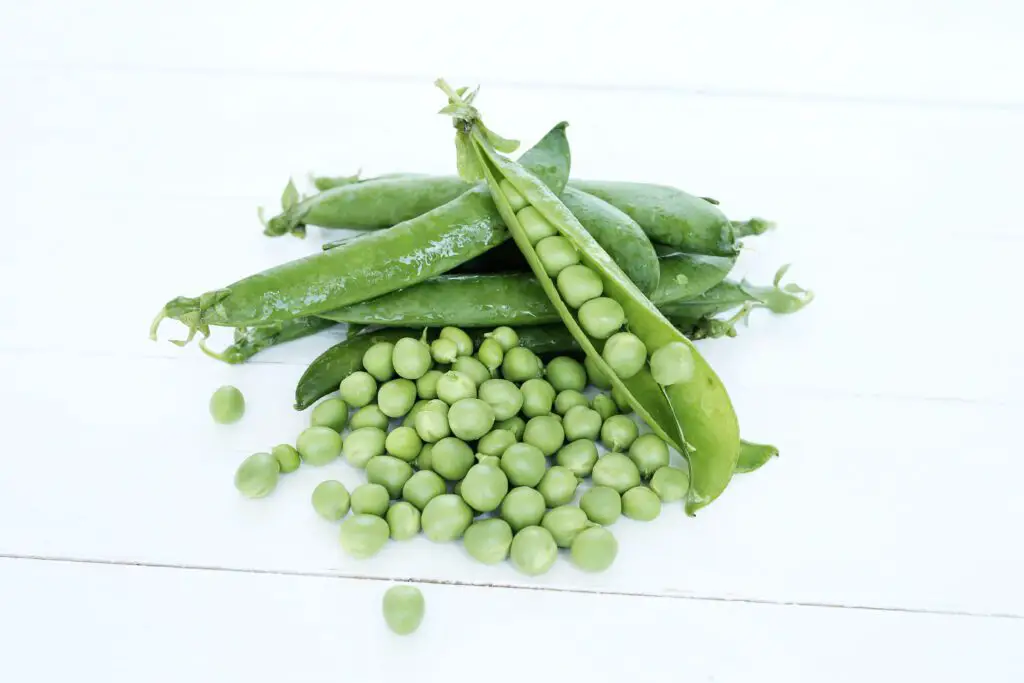
Sourcing quality pea seeds is a crucial step in successfully cultivating pea shoot microgreens. As an aspiring microgreen gardener, it is important to select seeds that are specifically suited for microgreen production. Look for reputable seed suppliers that specialize in microgreen varieties to ensure you are obtaining seeds of the highest quality.
When sourcing pea seeds for microgreen cultivation, be sure to consider the characteristics that make for an ideal microgreen variety. Look for seeds that have been tested and proven to perform well in microgreen production. These varieties should possess traits such as fast germination, high yields, uniform growth, and desirable flavor profiles. Additionally, opt for organic or untreated seeds whenever possible to minimize the risk of introducing chemicals or contaminants into your growing process.
Do thorough research on different seed suppliers and read customer reviews to gauge the quality and reliability of their products. Additionally, consider reaching out to local gardening communities or online forums to seek recommendations or ask for personal experiences with different seed suppliers. By sourcing high-quality pea seeds for your microgreen cultivation, you can ensure a successful and rewarding growing experience.
Preparing the Growing Medium for Pea Shoot Microgreens
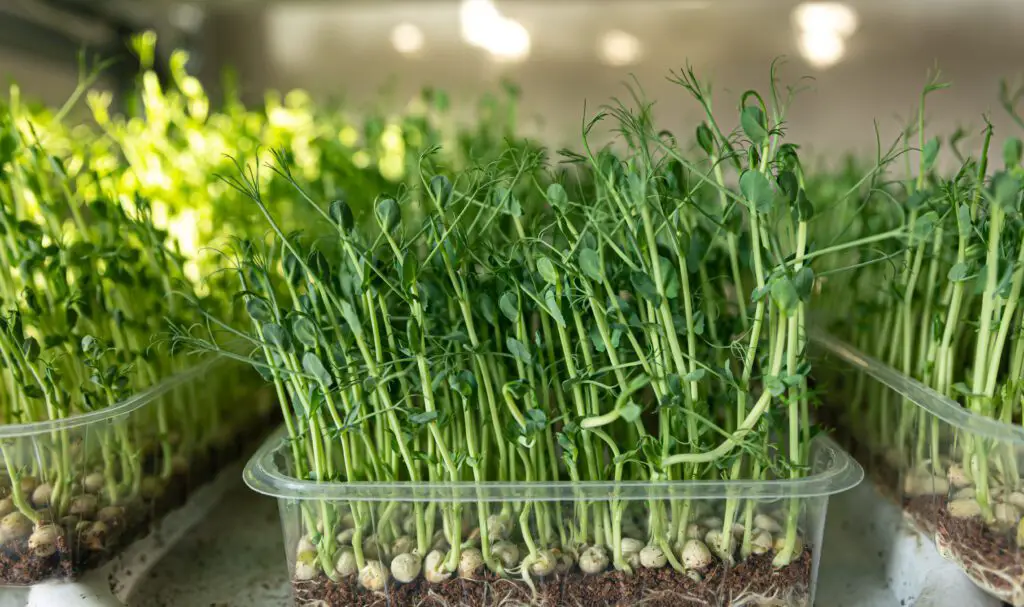
To ensure successful growth and development of pea shoot microgreens, it is crucial to adequately prepare the growing medium. The growing medium serves as the foundation for these delicate plants, providing them with the necessary support, nutrients, and moisture.
One common and effective growing medium for pea shoot microgreens is a soilless mix. This mixture is typically composed of peat moss, vermiculite, and perlite, which ensures optimal drainage while retaining the right amount of moisture. Prior to filling the tray or container with the growing medium, it is essential to moisten it to the proper consistency. This can be achieved by misting the mix with water and gently stirring it until it feels consistently damp but not overly saturated. The ideal moisture level is crucial for successful germination and root development, as it allows the seeds to take in water and nutrients without becoming waterlogged.
Additionally, it is important to sterilize the growing medium to minimize the risk of potential diseases or pests. Sterilization can be done by baking the soilless mix in an oven at a temperature of around 180-200°F (82-93°C) for approximately 30 minutes. This process eliminates any pathogens, weed seeds, or unwanted organisms that may hinder the growth and health of your pea shoot microgreens.
By taking the time to properly prepare the growing medium, you are setting the stage for healthy and vigorous pea shoot microgreens. This foundational step sets the tone for the entire cultivation process, ensuring optimal growing conditions and ultimately leading to a bountiful harvest.
Soaking and Preparing Pea Seeds for Germination
To ensure successful germination and healthy growth of pea shoot microgreens, it is crucial to properly prepare and soak the pea seeds before sowing. Soaking the seeds helps to kickstart the germination process by softening the seed coat and activating enzymes necessary for growth.
Before soaking, it is important to select high-quality pea seeds that are specifically labeled for microgreen cultivation. Look for seeds that are organic, untreated, and free from any damage or discoloration. These factors play a significant role in the overall viability and success of your pea shoot microgreens.
To prepare the seeds for soaking, start by placing them in a clean container. For every tablespoon of seeds, add around two to three times the amount of room temperature water. Allow the seeds to soak for approximately 8 to 12 hours, or overnight. This process helps to rehydrate the seeds and encourage the process of germination.
Keep in mind that different varieties of pea seeds may require slightly different soaking times, so it is advisable to refer to the specific instructions provided by the seed supplier. Once the soaking period is complete, drain off any excess water and transfer the seeds to a suitable growing medium for sowing. Preparing the pea seeds through soaking sets the stage for successful germination and ensures a strong start for your pea shoot microgreens.
Sowing Pea Seeds for Optimal Microgreen Growth
To ensure optimal growth of your pea shoot microgreens, proper sowing techniques are crucial. The first step is to select high-quality pea seeds that are specifically designated for microgreen cultivation. Look for varieties that are known for their fast germination and abundant foliage, such as Oregon Sugar Pod II or Little Marvel.
Before sowing, it is important to prepare the growing medium. Pea shoot microgreens thrive in a well-draining soilless mixture, such as coconut coir or a blend of peat moss and vermiculite. Fill your seed trays or containers with the growing medium, ensuring it is evenly distributed and lightly packed.
Once your growing medium is prepared, soak the pea seeds in water for about 12 to 24 hours. This helps to soften the seed coat and kick-start the germination process. After soaking, drain the water and spread the seeds evenly over the surface of the growing medium. Aim for a dense but not overcrowded layer of seeds, as this allows for optimal growth and prevents competition for nutrients.
Providing Adequate Light and Temperature for Pea Shoot Microgreens
Sufficient light and optimal temperature are two crucial factors for the successful cultivation of pea shoot microgreens. Light is essential for photosynthesis, the process by which plants convert light energy into chemical energy, enabling growth and development. Pea shoot microgreens require adequate light to thrive and reach their full potential.
When it comes to light, it’s important to place your trays or growing containers in a well-lit area. Ideally, you should provide pea shoot microgreens with around 12-16 hours of light per day. Natural sunlight is the best source of light, so if possible, position your trays near a south-facing window. However, if natural sunlight is limited, artificial grow lights can be used as a substitute. LED grow lights are an excellent choice as they provide the right spectrum of light for plant growth while consuming less energy.
In addition to light, maintaining the proper temperature is crucial for the successful growth of pea shoot microgreens. Peas generally prefer temperatures between 60-70°F (15-21°C). It’s important to ensure that the growing environment remains within this range to optimize growth and development. Extreme temperatures can stunt growth or even cause damage to the delicate shoots. Therefore, it’s advisable to monitor the temperature regularly and make any necessary adjustments to maintain the desired range.
Providing the right amount of light and maintaining the appropriate temperature can significantly impact the growth and quality of pea shoot microgreens. By paying attention to these factors, you can create an ideal environment that fosters robust and healthy pea shoot microgreens.
Proper Watering and Humidity Control for Successful Growth
To ensure the successful growth of pea shoot microgreens, proper watering and humidity control are essential factors that need to be considered. Watering the plants correctly and maintaining the optimal humidity levels will contribute to healthy growth and vibrant pea shoots.
When it comes to watering pea shoot microgreens, it is crucial to strike a balance. Overwatering can lead to root rot and other issues, while underwatering can result in stunted growth. The key is to provide enough moisture without saturating the growing medium. A good practice is to water the plants gently and evenly, allowing the excess water to drain away. It is advisable to use a spray bottle or a watering can with a fine nozzle to avoid disturbing the delicate shoots. Regularly check the moisture level of the soil or growing medium by pressing it gently with your finger. If it feels dry about half an inch below the surface, it’s time to water.
Maintaining the right humidity is also crucial for optimal growth. Pea shoot microgreens prefer moderate to high humidity, but excessive moisture can create a breeding ground for mold and other harmful pathogens. To control humidity, you can use a humidity dome or cover the tray with a plastic wrap, ensuring that it has some ventilation to prevent the formation of condensation. Another option is to use a humidifier or mist the plants with water occasionally, especially in dry climates. Monitoring the humidity levels regularly using a hygrometer can help you maintain the ideal range of around 60% to 70% relative humidity.
By paying close attention to proper watering techniques and humidity control, you can create the ideal environment for healthy pea shoot microgreens to flourish. Remember to monitor their progress closely and adjust watering and humidity levels as needed to ensure successful growth.
Managing Pest and Disease Issues in Pea Shoot Microgreens
Pea shoot microgreens can be susceptible to various pests and diseases, which can hinder their growth and development. It is essential for growers to proactively manage these issues to ensure healthy and vigorous pea shoot microgreens. One common pest that affects pea shoots is aphids. These small, sap-sucking insects can quickly multiply and cause damage to the tender leaves. To control aphids, it is recommended to introduce beneficial insects such as ladybugs or lacewings, as they are natural predators that feed on aphids. Additionally, regular monitoring of plants and prompt removal of infested leaves can help prevent the spread of aphids.
In terms of diseases, powdery mildew is a common problem that affects pea shoot microgreens. This fungal infection presents as a white, powdery substance on the leaves, stems, and other plant parts. Proper air circulation and reducing humidity levels in the growing environment can help prevent the development of powdery mildew. If detected, affected plants should be removed immediately to prevent the spread of the disease. Another potential disease that can affect pea shoot microgreens is damping-off, which is caused by various fungi. To prevent damping-off, growers should ensure proper drainage in the growing medium, avoid overwatering, and use sterile containers and growing media. Additionally, applying a preventive fungicide can be beneficial in controlling damping-off. By taking these preventive measures and promptly addressing pest and disease issues, growers can ensure healthy and thriving pea shoot microgreens.
Monitoring and Adjusting Nutrient Levels for Healthy Growth
To ensure healthy growth of your pea shoot microgreens, it is crucial to monitor and adjust nutrient levels throughout their cultivation. Nutrients are essential for the development and vitality of plants, providing them with the necessary elements for photosynthesis, root development, and overall growth. By maintaining optimal nutrient levels, you can promote robust and thriving pea shoot microgreens.
Regularly monitoring nutrient levels is essential in keeping your pea shoot microgreens healthy. A simple and effective way to do this is through regular testing of your growing medium. Conducting nutrient analysis helps you determine the current nutrient levels and identify any deficiencies or excesses. This information can guide you in making appropriate adjustments to maintain a well-balanced nutrient profile. Additionally, it is important to monitor pH levels, which influence nutrient availability to the plants. Maintaining the correct pH range for your pea shoot microgreens ensures optimal nutrient absorption and uptake.
Once you have identified any nutrient imbalances or deficiencies, it is important to take action to rectify the situation. Adjustments can be made by adding specific fertilizers or nutrients to your growing medium. There are various nutrient solutions available in the market specifically formulated for microgreen cultivation. These solutions typically contain an appropriate balance of essential nutrients required for healthy growth. By following the recommended application rates, you can correct deficiencies and provide your pea shoot microgreens with the necessary nutrients they need to thrive.
| Nutrient Parameter | Optimal Range |
|---|---|
| pH Levels | 6.0 to 6.8 |
| EC/TDS Levels | 1.2 to 2.0 mS/cm |
| Nutrient Solution Temperature | 18°C to 21°C |
| Macronutrient Ratios | – Nitrogen (N): 100-150 ppm |
| – Phosphorus (P): 50-100 ppm | |
| – Potassium (K): 150-200 ppm | |
| Micronutrient Concentrations | – Iron (Fe): 2-5 ppm |
| – Manganese (Mn): 0.5-2 ppm | |
| – Zinc (Zn): 0.1-0.5 ppm | |
| – Copper (Cu): 0.1-0.5 ppm | |
| – Boron (B): 0.5-1 ppm | |
| Nitrate Levels | Below 150 ppm |
| Ammonium Levels | Below 10 ppm |
Remember that each stage of your pea shoot microgreens’ growth may require different nutrient levels. For instance, during the early germination and seedling stage, higher proportions of nitrogen (N) are beneficial for foliage production. As your pea shoot microgreens mature, a greater focus on phosphorus (P) and potassium (K) will support strong root development, flowering, and fruiting. Regularly monitoring and adjusting nutrient levels based on the growth stage ensures optimal nutrition and promotes healthy growth throughout the entire cultivation cycle.
Understanding the Harvesting Time for Pea Shoot Microgreens
Harvesting pea shoot microgreens at the right time is crucial to ensure optimal flavor, texture, and nutrient content. Generally, pea shoots are ready to be harvested when they have reached a height of around 3 to 4 inches. At this stage, they are young and tender, with vibrant green leaves and delicate stems.
To determine the ideal harvesting time, closely observe the growth of the pea shoots. Look for the appearance of the first true leaves and the overall appearance of the plants. If the shoots have developed all their true leaves and the stems are becoming slightly thicker, it indicates that they are at their peak flavor and nutritional value.
Timing is of utmost importance when harvesting pea shoot microgreens as they can rapidly grow and become overmature. Delaying the harvest may result in tougher stems and a decrease in overall quality. Therefore, it is recommended to regularly monitor the growth progress and harvest the pea shoots promptly when they reach the desired stage.
Techniques for Harvesting Pea Shoot Microgreens
Harvesting pea shoot microgreens requires careful attention to ensure optimal flavor, texture, and nutrient content. The timing of the harvest plays a crucial role in determining the quality of the microgreens. The ideal time to harvest pea shoots is when the first set of true leaves appear, usually around 10-14 days after sowing. At this stage, the shoots have reached a desirable height of 2-3 inches, providing a balance between tenderness and flavor intensity.
To harvest the pea shoots, gently grip the base of the stem close to the growing medium and use a sharp pair of scissors or pruning shears to cut them just above the surface. Avoid pulling or yanking the shoots, as this can damage the delicate roots and surrounding plant tissue. It’s best to harvest the pea shoots just before you plan to use them, as they are highly perishable and lose their quality and nutritional value quickly after cutting. However, if you need to store them, place them in a plastic bag or an airtight container and refrigerate them for up to 3-4 days.
Remember that consistency is key when it comes to harvesting pea shoot microgreens. Regularly monitor the growth of your plants and adjust your harvesting schedule accordingly. By harvesting at the right time, you can enjoy the delicate and fresh pea flavor in your dishes while also maximizing the nutritional benefits of these vibrant and nutrient-packed microgreens.
Storing and Preserving Pea Shoot Microgreens for Prolonged Freshness
When it comes to storing and preserving pea shoot microgreens, proper handling is crucial to maintain their freshness and flavor for an extended period. After harvesting, it is important to gently remove any moisture from the pea shoots using a clean towel or paper towels. Excess moisture can lead to wilting and decay, reducing the shelf life of the microgreens. Avoid washing them unless necessary, as this can introduce additional moisture. Instead, focus on keeping the microgreens dry and refrigerated to maintain their vibrant appearance and texture.
To store pea shoot microgreens, place them in an airtight container or resealable plastic bag, ensuring that they are not overcrowded. If possible, place a paper towel or a dry, clean cloth at the bottom of the container to absorb any excess moisture. Store the container in the refrigerator, preferably in the crisper drawer where humidity levels are higher. Proper storage can help preserve the pea shoot microgreens for up to a week, although it is best to consume them as soon as possible to enjoy their optimal taste and nutritional benefits.
By following these simple methods for storing and preserving pea shoot microgreens, gardening enthusiasts can extend the shelf life of their harvest and continue to savor the vibrant flavors and nutritional content of these delicate greens. With a little care and attention, the efforts put into growing pea shoot microgreens can be enjoyed for an extended period, giving gardeners a bountiful supply of fresh and healthy greens to incorporate into their culinary creations.
Culinary Uses and Nutritional Benefits of Pea Shoot Microgreens
Pea shoot microgreens not only add a burst of vibrant color to any dish, but they also offer a wide range of culinary uses and nutritional benefits. These tender and flavorful greens have a mild, sweet taste with hints of fresh peas, making them a versatile ingredient in various recipes.
In terms of nutritional benefits, pea shoot microgreens are packed with essential vitamins and minerals. These tiny greens are an excellent source of vitamin C, vitamin A, and vitamin K. They are also rich in folate, which is essential for cell growth and development, and iron, which helps in oxygen transportation throughout the body. Additionally, pea shoot microgreens are a good source of antioxidants, such as beta-carotene and lutein, which have been linked to various health benefits, including reduced risk of chronic diseases.
When it comes to culinary uses, pea shoot microgreens can be used in salads, sandwiches, stir-fries, and as a garnish for soups and main dishes. Their delicate texture and fresh flavor complement a wide range of ingredients, adding a touch of visual appeal and a subtle crunch to the dish. These microgreens can also be blended into smoothies or juiced for an extra boost of nutrients. The possibilities are endless when it comes to incorporating pea shoot microgreens into your culinary creations.
Exploring Different Recipes and Dishes with Pea Shoot Microgreens
Pea shoot microgreens are not only visually appealing but also pack a powerful punch of flavors and nutrients, making them an excellent addition to a wide variety of recipes and dishes. Their delicate texture and slightly sweet taste make them a versatile ingredient that can elevate the flavors of both savory and sweet creations.
One popular way to enjoy the freshness of pea shoot microgreens is by incorporating them into salads. Their tender leaves and crunchy stems provide a refreshing contrast to other salad ingredients, while their vibrant green color adds a visually appealing element to the dish. Whether you’re making a classic green salad or experimenting with more creative combinations, such as adding them to a summer fruit salad, pea shoot microgreens can bring a unique twist to your bowl.
In addition to salads, pea shoot microgreens can also be used as a flavorful garnish for soups, sandwiches, and wraps. Their subtle sweetness can balance the richness of a creamy soup or add a burst of freshness to a hearty sandwich. Try sprinkling them on top of a bowl of tomato soup or tucking them into a wrap filled with grilled vegetables and protein for an extra layer of taste and texture.
Moreover, pea shoot microgreens can make an excellent addition to smoothies and juices, providing an added dose of vitamins and antioxidants. Their mild flavor blends well with other fruits and vegetables, allowing you to create nutritious and delicious concoctions. Simply toss a handful of pea shoot microgreens into your blender along with your favorite fruits and liquid base, and blend until smooth for a refreshing and nutrient-packed beverage.
Whether you’re a seasoned chef or a home cook looking to experiment with new flavors, exploring different recipes and dishes with pea shoot microgreens opens up a world of culinary possibilities. From salads and soups to smoothies and more, these tiny greens can add a burst of freshness and nutrition to your meals. So, get creative in the kitchen and enjoy the vibrant flavors that pea shoot microgreens have to offer.
Troubleshooting Common Issues in Growing Pea Shoot Microgreens
Pea shoot microgreens are generally easy to grow but, like any other crop, they can face some common issues that may hinder their growth and development. It is important for growers to be aware of these potential problems and know how to troubleshoot them effectively.
One common issue in growing pea shoot microgreens is poor germination. If your seeds are not sprouting or if you notice a low germination rate, the problem could be related to the quality of the seeds or the germination conditions. Ensure that you are sourcing high-quality seeds from reputable suppliers. It is also crucial to provide the seeds with optimal germination conditions, including the right moisture levels, temperature, and light. In some cases, presoaking the seeds before sowing can also help improve germination rates.
Another common problem that growers may encounter is the development of diseases or pests. Pea shoot microgreens can be susceptible to fungal diseases such as damping-off or powdery mildew. To prevent or manage these issues, it is important to maintain good hygiene practices, such as using sterilized growing media and clean equipment. Additionally, monitoring the humidity levels and providing adequate air circulation can help prevent the development of fungal diseases. When it comes to pests, such as aphids or mites, early identification and appropriate pest management strategies like using insecticidal soaps or introducing beneficial insects can help control their population and minimize damage to the pea shoot microgreens.
By being aware of these common issues and following appropriate troubleshooting techniques, growers can overcome obstacles and ensure successful growth and yield of their pea shoot microgreens. Stay tuned to our upcoming articles where we will delve deeper into other aspects of growing and harvesting these nutritious greens.
What is the ideal temperature for growing pea shoot microgreens?
The ideal temperature for growing pea shoot microgreens is between 60°F and 75°F (15°C and 24°C).
How often should I water my pea shoot microgreens?
It is recommended to water your pea shoot microgreens once or twice a day, ensuring that the growing medium is moist but not waterlogged.
What are some common pests that may affect pea shoot microgreens?
Common pests that may affect pea shoot microgreens include aphids, fungus gnats, and spider mites.
How can I prevent pest infestations in my pea shoot microgreens?
To prevent pest infestations, you can regularly inspect your microgreens for any signs of pests, practice good hygiene by keeping the growing area clean, and consider using organic pest control methods such as neem oil or insecticidal soap.
What are some signs of nutrient deficiency in pea shoot microgreens?
Signs of nutrient deficiency in pea shoot microgreens may include stunted growth, yellowing leaves, or discoloration.
How can I adjust nutrient levels in my pea shoot microgreens?
You can adjust nutrient levels in your pea shoot microgreens by using a balanced organic fertilizer or by providing a nutrient-rich growing medium.
When is the best time to harvest pea shoot microgreens?
The best time to harvest pea shoot microgreens is when they reach a height of 2-3 inches (5-7.5 cm) and have developed two sets of true leaves.
How should I store harvested pea shoot microgreens?
Harvested pea shoot microgreens can be stored in a sealed container in the refrigerator. It is recommended to place a paper towel or moisture-absorbing pad in the container to absorb excess moisture and maintain freshness.
What are the nutritional benefits of pea shoot microgreens?
Pea shoot microgreens are rich in vitamins
Can pea shoot microgreens be used in cooking?
Yes, pea shoot microgreens can be used in a variety of dishes such as salads, sandwiches, stir-fries, and smoothies. Their delicate and sweet flavor adds a fresh and vibrant touch to meals.

